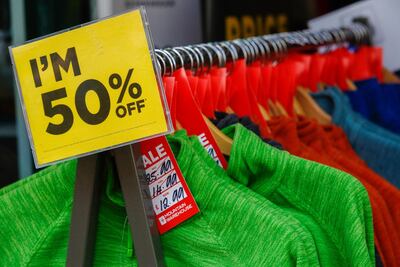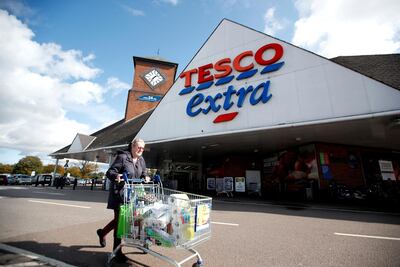Britain’s inflation rate picked up to 0.7 per cent in October, boosted by rises in the prices of clothing, footwear and food as coronavirus restrictions tightened across the UK.
The higher-than-expected rise in the annual inflation rate, which tracks the price of goods and services, came after an increase of 0.5 per cent in September, according to data from the Office for National Statistics.
"The rate of inflation increased slightly as clothing prices grew, returning to their normal seasonal pattern after the disruption this year," said ONS deputy national statistician for economic statistics Jonathan Athow.
“The cost of food also nudged up, while second-hand cars and computer games also all saw price rises.”
The latest figures show that inflation is "well past its crisis low point" of 0.2 per cent seen in August, said Paul Dales, chief UK economist at Capital Economics. This came after UK finance minister Rishi Sunak's 'Eat Out to Help Out' discount dining scheme helped to push the country's inflation rate to its lowest level since December 2015.
While shops and businesses reopened over the summer and early autumn, the country has now been plunged into its second lockdown to help contain a second surge in Covid-19 cases, which will have a downward effect on next month's inflation rate.
“Unfortunately the Christmas shopping season has been put on hold with the second lockdown and regional restrictions in full swing, with concerns of sustained restrictions once the English lockdown ends at the start of December,” said Richard Pearson, director at investment platform EQi.
"Retailers and restaurants have been forced to close up shop in what should be their busiest period in order to help stem the tide of Covid cases. Although online retailers will flourish during this period, as they did with the first lockdown, we will undoubtedly see a blow to next month’s figures.”
The bulk of October’s rise was due to increases in clothing and food inflation, as the effects of the pandemic also continued to push up second-hand car and hairdressing prices.

While clothing and footwear traditionally make a downward contribution to the headline inflation rate, as they follow clear seasonal patterns with falls in June and July when items are placed on sale, the reverse has been recorded this year. There was increased discounting in March and April in response to the lockdown, while prices in October rose from a year earlier.
People shopping for home decorations, such as furniture, furnishing and carpets, also contributed to October's inflation rate rise, with the contribution from these three groups totalling 0.16 percentage point.
While food prices rose in October, unlike last year, with people stocking up on potatoes and fruit, some surveys of consumers had pointed to renewed stockpiling as health restrictions spread through Scotland, Wales and Northern Ireland in October. A one-month lockdown was announced for England at the end of the month and started on November 5.

“Food inflation may continue to rise in November as demand in the supermarkets increases further during the Covid-19 lockdown. But it is hard to see how clothing inflation can continue to climb under such conditions. And the previous jump in inflation of IT equipment, which was due to supply shortages, has started to reverse,” Mr Dales said.
There were also pockets of disinflation he said, with recreation and culture inflation dropping back from 2.4 per cent to 2 per cent.
“Both total and core inflation will start to rise more sharply from April when the temporary VAT cut for the hospitality sector is reversed and the downward drag from the previous plunge in fuel prices drops out of the annual comparison,” Mr Dales said.
“But we suspect that the weak economy will prevent a sustained period where inflation is above the 2 per cent target, unless there is a no-deal Brexit.”


